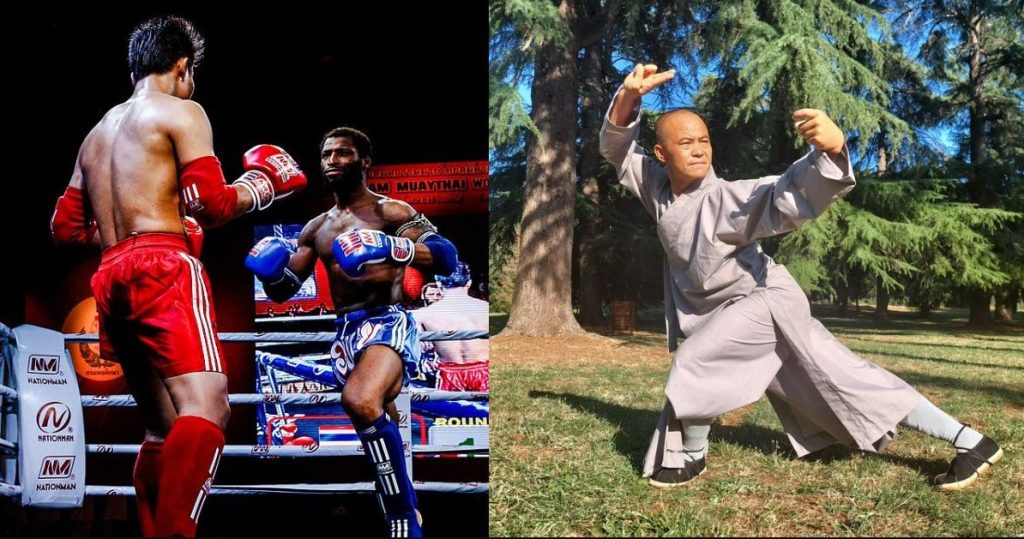Martial arts have fascinated practitioners and spectators for centuries. Among the most recognized styles in the world are Karate, a traditional Japanese martial art, and Muay Thai, a striking-heavy combat sport from Thailand. While both styles focus on discipline, physical fitness, and striking techniques, their philosophies, training methods, and practical applications differ significantly.
Table of Contents
1. Origins and Philosophy
| Aspect | Karate | Muay Thai |
|---|---|---|
| Country of Origin | Japan (Okinawa) | Thailand |
| Historical Roots | Influenced by Chinese Kung Fu and Okinawan fighting techniques | Developed from ancient Thai battlefield tactics |
| Philosophy | Dojo etiquette, self-discipline, self-defense | Respect, honor, toughness, ring combat |
| Meaning | “Empty hand” (kara = empty, te = hand) | “Art of Eight Limbs” |
Karate developed in Okinawa as a way to defend oneself without weapons. It emphasizes personal development, humility, and respect. Meanwhile, Muay Thai evolved as a battlefield art, with an emphasis on practical effectiveness and toughness. While both arts value respect and discipline, Karate leans more towards spiritual and personal growth, whereas Muay Thai focuses on conditioning and effectiveness.
2. Techniques and Striking Styles
| Technique Category | Karate | Muay Thai |
|---|---|---|
| Main Strikes | Punches, kicks, open-hand techniques | Elbows, knees, punches, kicks |
| Specialty | Linear attacks, high kicks, quick strikes | Clinch work, devastating elbows and knees |
| Stance | Upright, side-facing, light on feet | Square, forward-facing, heavy on lead leg |
| Movement | Point-based, darting in and out | Plodding, methodical, close-range movement |
Karate practitioners often train in kata (forms) and kumite (sparring), emphasizing precise, controlled strikes. Kicks are usually high and flashy. Muay Thai, in contrast, emphasizes power over form. It is known for its use of all eight limbs (hands, elbows, knees, and legs), with brutal effectiveness in close-range combat.
3. Training Methods
| Aspect | Karate | Muay Thai |
|---|---|---|
| Typical Class Structure | Kihon (basics), Kata (forms), Kumite (sparring) | Warm-up, pad work, bag work, sparring, clinch |
| Sparring Style | Point-based, light contact (in many styles) | Full-contact, continuous striking |
| Physical Conditioning | Moderate | Intense (running, body hardening, conditioning) |
| Focus | Precision, technique, tradition | Power, endurance, fight readiness |
Karate training usually includes structured drills, repetition, and kata to develop form and control. In contrast, Muay Thai training emphasizes intense physical conditioning, often including 5-10 km runs, hundreds of kicks and knees, and heavy sparring.
4. Self-Defense and Real-World Application
| Category | Karate | Muay Thai |
|---|---|---|
| Street Effectiveness | Varies by style and practitioner | High, due to emphasis on full-contact |
| Clinch Work | Minimal | Extensive |
| Ground Defense | Generally limited | Minimal (though some modern training adds it) |
| Weapon Defense | Some traditional training (e.g., Kobudo) | Rare, not core to Muay Thai |
Muay Thai is widely considered one of the most effective striking arts in self-defense and mixed martial arts (MMA). Its powerful clinch work, devastating strikes, and conditioning prepare practitioners for real-world situations. Karate can also be effective, but its application varies widely based on the school and style (e.g., Kyokushin is more full-contact, while Shotokan is more traditional and point-based).
5. Use in MMA and Competition
| Aspect | Karate | Muay Thai |
|---|---|---|
| Popularity in MMA | Moderate (Lyoto Machida, Stephen Thompson) | High (Anderson Silva, Joanna Jędrzejczyk) |
| Sport Rules | Point fighting, light or semi-contact tournaments | Full-contact, rounds with elbows and knees |
| Adaptability | Depends on style (some less suited to MMA) | Very well-suited to MMA |
Muay Thai is a staple in MMA due to its direct application, particularly in striking and clinch control. Karate, especially when modified for modern combat (as seen in Machida or Thompson), can be effective, particularly for its movement and counter-striking.
6. Belt Systems and Ranking
| Aspect | Karate | Muay Thai |
|---|---|---|
| Belt System | Yes (white to black and beyond) | No formal belts (uses traditional titles, e.g., Kru) |
| Ranking Evaluation | Based on kata, techniques, sparring | Based on fight experience and instructor evaluation |
| Progression Time | Structured, usually several years | Depends on fight experience and training |
Karate has a clear ranking system through colored belts, which motivates students and marks their progress. Muay Thai, in contrast, doesn’t traditionally use belts. Status is earned through fights and time spent training under a Kru (teacher).
7. Cultural and Mental Aspects
| Aspect | Karate | Muay Thai |
|---|---|---|
| Dojo Etiquette | Highly formalized (bows, rituals, uniforms) | Respectful but less formalized |
| Uniform | Gi and colored belt | Shorts, hand wraps, traditional armbands |
| Mental Discipline | Strong emphasis on “Do” (way/path) | Strong mental toughness through conditioning |
Both arts emphasize respect, but Karate incorporates more ritual and tradition. Muay Thai traditions include the Wai Khru Ram Muay (pre-fight dance), but day-to-day training tends to be more informal compared to the structure of a karate dojo.
Which One Is Better?
Choosing between Karate and Muay Thai depends on your personal goals. Here’s a quick comparison for different objectives:
| Goal | Better Choice | Why |
|---|---|---|
| Self-defense | Muay Thai | More effective in close-range and full-contact |
| Discipline and tradition | Karate | Strong philosophical and ethical grounding |
| Physical conditioning | Muay Thai | Tough, endurance-based training |
| Flexibility and technique | Karate | Precise movements and body control |
| MMA preparation | Muay Thai (with Karate useful for movement) | More directly applicable to modern combat sports |
| Children and beginners | Karate | Structured learning and focus on development |
Ultimately, both arts offer tremendous value, and many martial artists cross-train in both to take advantage of their unique strengths. Whether you’re drawn to the discipline of Karate or the intensity of Muay Thai, both paths lead to self-improvement, confidence, and a deeper understanding of martial arts.
Karate and Muay Thai each represent a unique martial tradition with strengths and philosophies all their own. By understanding their differences — from origins and techniques to training and applications — you can make a more informed decision about which art best suits your goals.
Whether you’re seeking self-defense skills, competitive success, or personal growth, either martial art can be a powerful tool for transformation.


